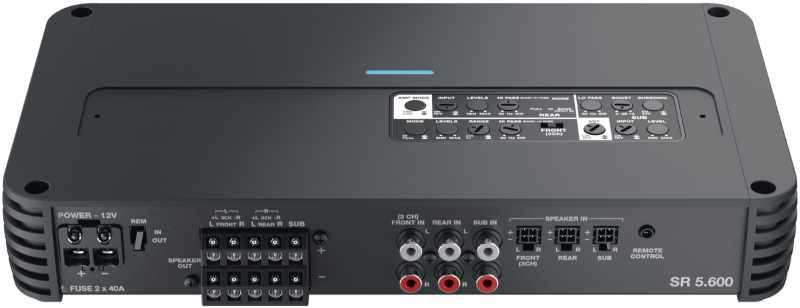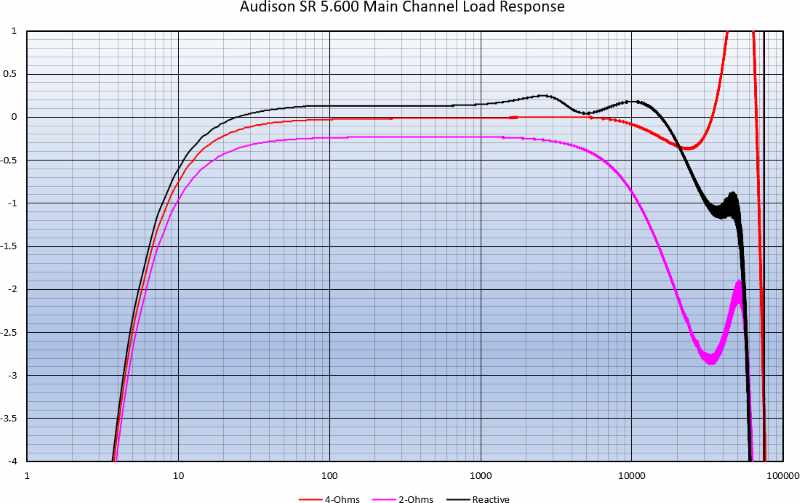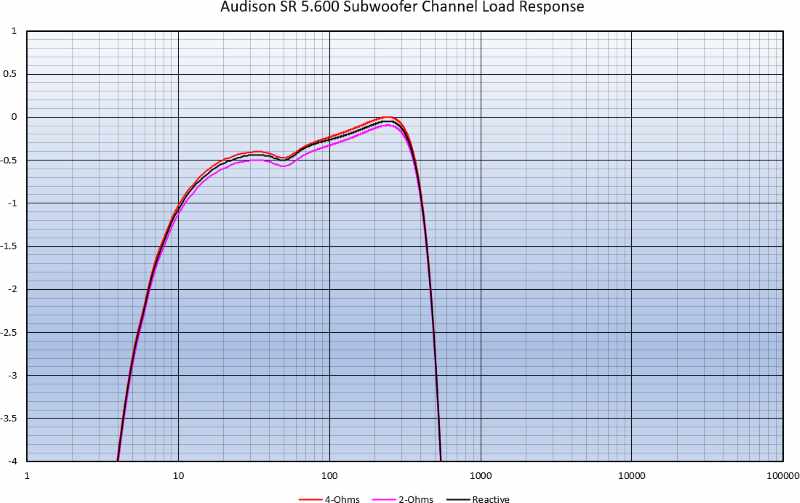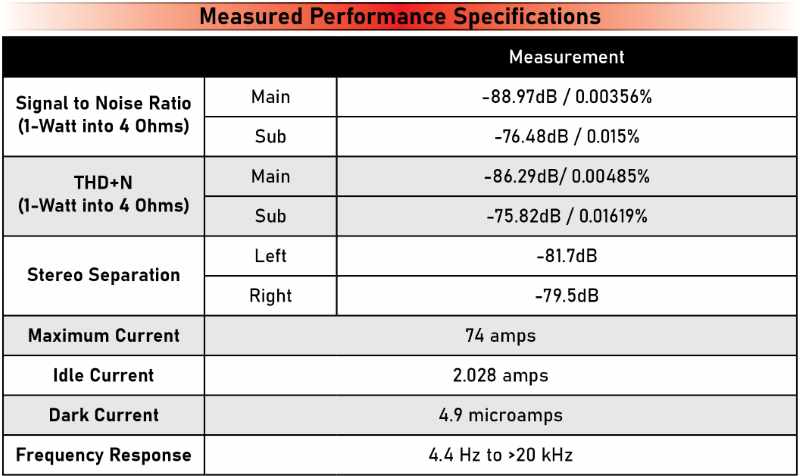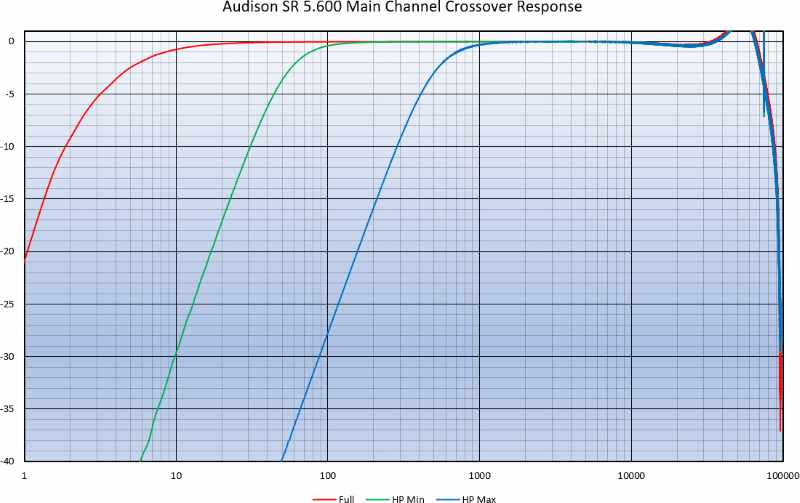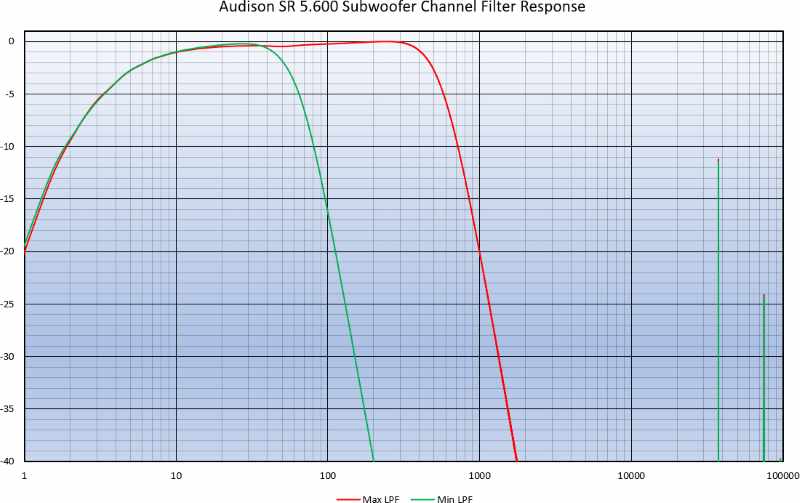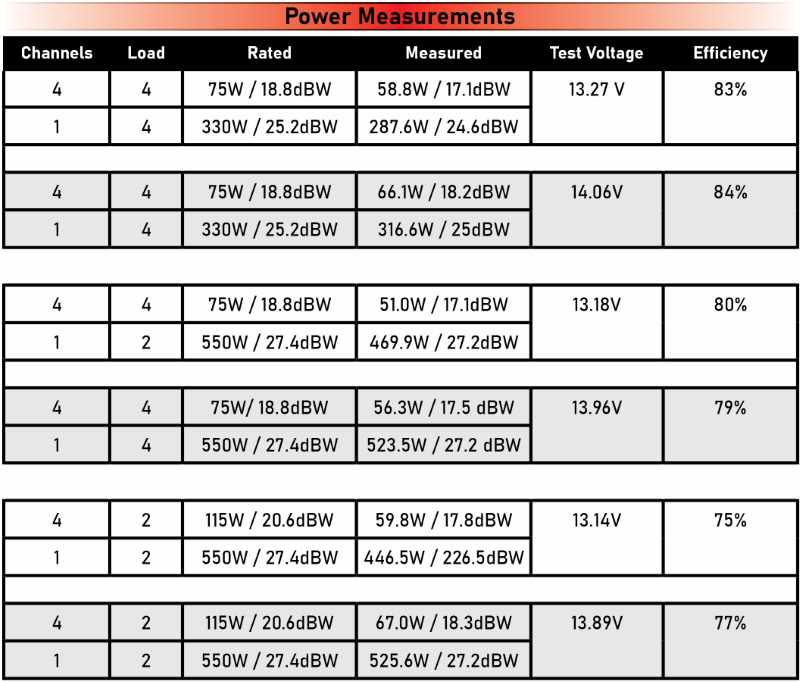While it’s fun to play with flagship products like Audison Thesis amplifiers and speakers, the reality is that there’s a lot more business done at the opposite end of the financial spectrum. The latest generation of the SR line from Audison gives car audio enthusiasts an affordable upgrade option that is laden with the features found in much more expensive solutions. For this Test Drive Review, I have one of the new SR 5.600 five-channel amplifiers on my bench. Let’s check it out!
Audison SR 5.600 Five-Channel Amplifier Design
The SR 5.600 is based on a powder-coated aluminum extrusion and features custom tooled cast-aluminum end caps. The rear edge of the amp has shallow fins that extend around the sides into the end cap design. Audison puts the main extrusion through a secondary milling process to add an LED and control panel access to the amp’s top. The controls are concealed by an aluminum cover with a black hairline finish. The Audison logo is engraved into this cover, and it’s held in place by a pair of flat head screws. The amplifier measures 11.57 by 6.1 inches and stands 1.87 inches tall. This chassis is small enough to fit under the seat of most vehicles. The amplifier can be mounted using the provided Philips-head hardware through holes in the end caps we mentioned earlier. A pair of 25-amp ATC-style automotive fuses are recessed into the left-side end cap.
Peering under the removable top cover reveals the configuration switches and controls for the amp. The controls are grouped into adjustments for the front, rear and subwoofer channels. Starting at the top left of the controls, an Amp Mode switch allows your installer to select between three- and five-channel operations. In the five-channel mode, the four main channels work in stereo pairs. When switched to the three-channel mode, the front pair of channels can be used in a bridged configuration to power a single left speaker and the rear channels are can be bridged for a right speaker. A signal flow diagram on page 65 of the owner’s manual will help your installer understand the signal path.
Each set of channels has a dedicated stereo input level control that’s adjustable from 0.2 to 5 volts RMS in low-input mode and 0.8 to 20 volts when the provided speaker-level input plugs are in use. The front channels have a button that selects between full-range and high-pass filtering. The filter adjustment is labeled as being adjustable between 50 and 500 Hz and uses a second-order -12 dB/octave filter slope. An x10 switch is available to change the range of the crossover frequencies to 500 Hz to 5 kHz if you want to use the front channels to run a tweeter or a small coaxial driver.
For the rear channels, your installer can use the dedicated pre-amp or speaker level inputs or press the Input switch, and the amp will route the left and right signals from the front channels to the corresponding rear channels. In terms of crossovers, a three-position switch allows for full-range, high-pass or bandpass filtering. The provided control allows for adjustability between 50 and 500 hertz in high-pass mode. When set to Band, the crossover setting on the front channels acts as a low-pass filter, and the rear channel crossover control setting determines the high-pass frequency. This configuration is ideal for using a midrange speaker or midbass driver to create a three-way actively filtered system.
The subwoofer channel includes another 50 to 500 Hz crossover adjustment. A button labelled Subsonic enables a 25 Hz, -24 dB/octave infrasonic filter. A bass boost control allows your installer to dial in up to 12 dB boost at 50 Hz. Finally, the input on/off control selects between the dedicated sub pre-amp or speaker level inputs and the option of sourcing the audio signal from the front channel input connections.
The last control on the top of the amp is ART, which stands for Automatic Remote Turn-on/off. When enabled, the amplifier will turn itself on automatically when it detects that the factory radio connected to the speaker level inputs has been turned on. In addition, Audison includes a remote turn-on output connection, so the amp can turn on a second device once it detects a signal. Continuing on the factory radio integration features, it’s worth noting that Audison includes their Universal Speaker Simulator technology in the amp. This feature presents the source unit connected to the speaker-level inputs with a simulated load. These loads are required for some factory radios to function correctly. It’s also a necessity for most factory-installed Class D amplifiers.
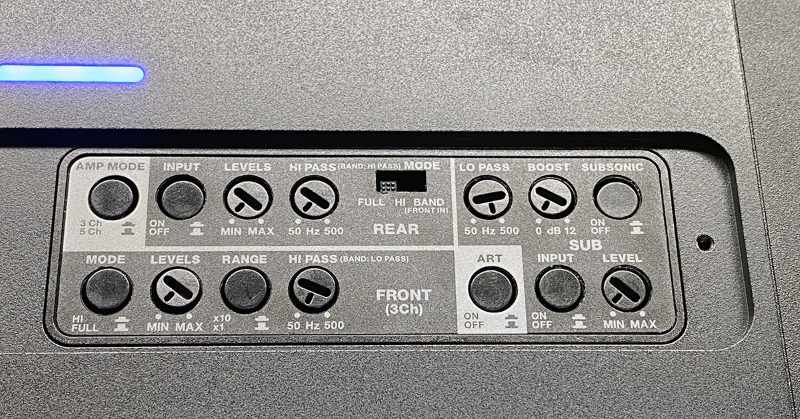
System Amplifier Connections
The front edge of the amp is home to two terminal blocks, six RCA jacks, four Molex connectors and a 1/8-inch jack. The power connection block on the far left of the amp has two terminals with a diameter of 0.217 inch and can accept 6- or 8-AWG power cables. Angled set screws with hex heads hold the wire securely once tightened. The 10-position speaker terminal block uses similar angled screws, and the terminals have a diameter of 0.158 millimeter to accept up to 12-AWG cables.
A two-position Molex connector beside the power terminal handles remote turn-on input and output connections. There are four four-position Molex connectors to the right of the centrally-located RCA jacks for the speaker level inputs. The 1/8-inch jack on the far right is for the optional VCR-S1 remote level control. The control provides -20 to +6 dB adjustment over the subwoofer output level when connected. The driver can fine-tune the bass to their music preference, listening style or mood.
Removing the bottom panel reveals a very organized circuit board that’s securely attached to what would be the front of the amp chassis. The control buttons and switches are on a pair of daughterboards that connect to the mainboard with gold-plated pins. These connections are rock solid and show no potential vibration issues. There’s a small cap and choke on the power input connection and a large multi-tap transformer in the corner of the amp. In terms of power supply filtering and energy storage, there’s a pair of 3,300 microfarad, 50-volt caps on the inputs and two larger 2,200 microfarad, 80-volt caps on the outputs. All are rated for 221 degrees F (105 degrees C).
All the components on the mainboard are surface-mount devices, showing that this is a modern design. The amp uses a combination of through-hole and surface-mount output switching devices. The inductors for the full-range channels are shielded, and those shields are secured to the board with black adhesive. Overall, everything looks great, modern and well thought-out. The fit and finish are immaculate, and the amplifier feels solid and well-constructed.
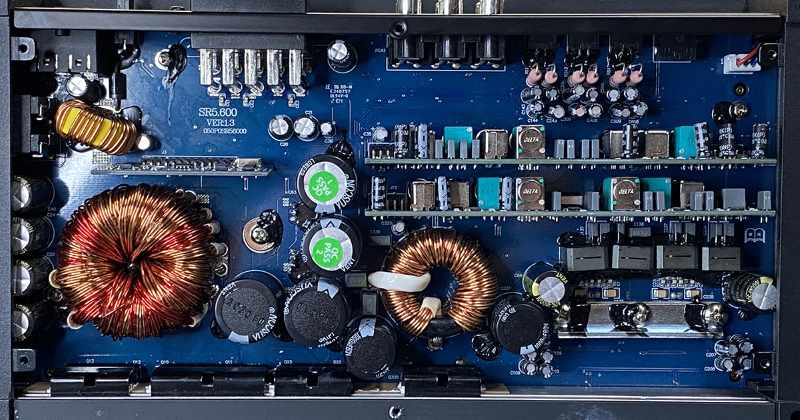
Specifications and Ratings
Audison rates the SR 5.600 to produce 75 watts per channel from the four main outputs and 330 watts from the subwoofer channel when connected to 4-ohm speakers. With 2-ohm loads, the power output increases to four by 115 watts and 550 watts, respectively. The main channels are rated to produce 230 watts of power when bridged to 4-ohm speakers.
Distortion is listed as being 0.02% at 1 kHz, and 70% rated power into a 4-ohm load. The signal-to-noise ratio is listed as 105 dBA with 1 volt of input. We assume that measurement was provided with the sensitivity controls set at their lowest levels and the amplifier producing full power. We’ll check the ANSI/CTA-2006-C compliant numbers once we get the amp on the test bench. Frequency response is listed as 10 to 35 kHz for the main channels and 10 to 500 Hz for the subwoofer channel.
Idle current when on is listed at 2.2 amps, and dark current at 40 microamps. Notably, the operating voltage is specified as being 6.5 to 17 volts. The lower voltage is crucial for vehicles with stop-start technology, and the high 17-volt spec is vital to some of the new Chevrolet trucks that charge at over 16 volts. Kudos to Audison for taking all of these electrical system challenges into consideration. This isn’t something you see on many amplifiers at any price!
Bench Testing the Audison SR 5.600 System Amplifier
The first test is to measure frequency response. Next, I measured the output of the amp, referenced to 2.0 Vrms using my QuantAsylum QA402 Audio Analyzer. The red trace shows the 4-ohm response, and the magenta trace is the 2-ohm response. The black trace shows the amp’s response into our simulated reactive speaker load. This circuit mimics the test used in Stereophile magazine and shows how complex crossovers can alter the response of an amplifier. Next, I repeated the tests for the subwoofer channel.
There is some high-frequency roll-off on the top end when loaded to 2 ohms. At 20 kHz, the output was down just over 2 dB. Since few of us can hear much over 15 kHz, this isn’t an issue. The peak at about 55 kHz on the full-range channels is typical for a Class D amplifier and is part of the output filter network.
Next, it was time to check the amp for noise and distortion. I started by evaluating the harmonic content of a 1 kHz tone using the QA402 analyzer. Next, I did the same for the subwoofer channel using a 60 Hz stimulus.
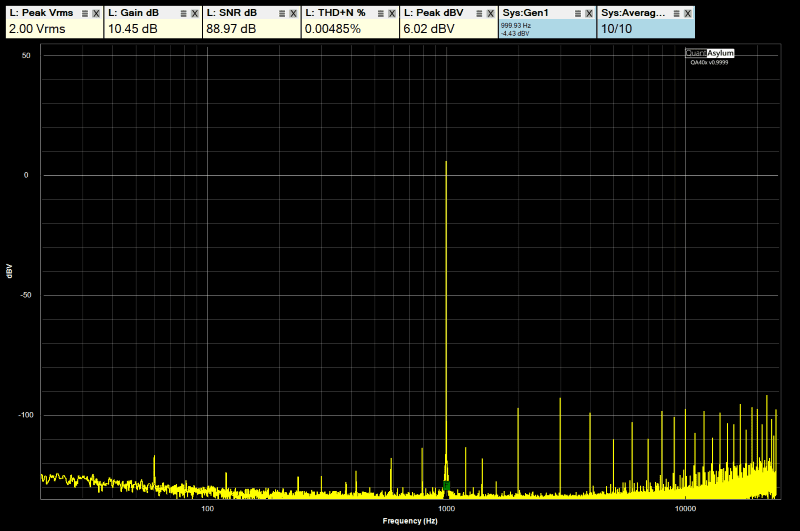
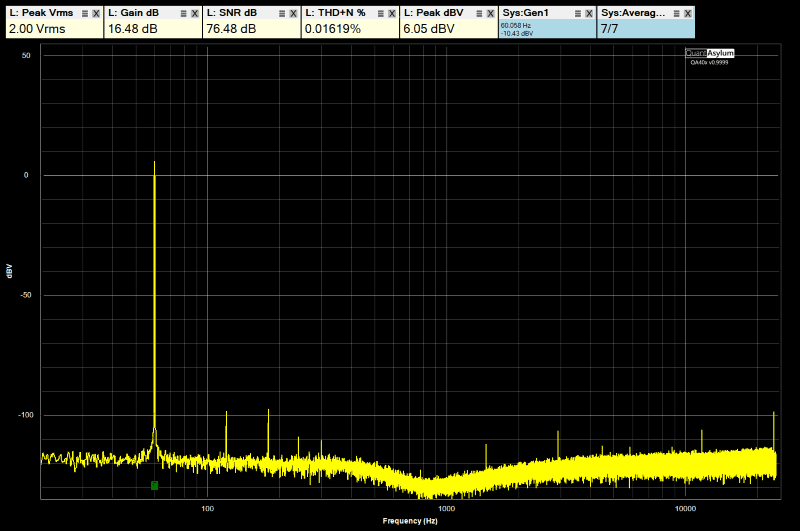
The distortion and noise measurements are pretty impressive for a Class D amplifier. Clearly, the lads in Italy have put significant effort into the design of this product. I have listed the frequency response as capable of exceeding 20 kHz since the resonance of the Class D filter makes it hard to identify a specific -3 dB point.
The subsequent measurements show how the crossovers and bass boost controls affect the main and subwoofer channels.
I always take power measurements last. Full disclosure: I do my listening before I measure anything. That way, what I hear isn’t tainted by something I may have seen in a measurement. Also, there’s a much higher chance of an amp being damaged while being measured.
Power measurements are taken at 2- and 4-ohm loads with all channels driven to 1% THD+N. Driving all channels to full power simultaneously makes this a VERY difficult test.
My power supply bank isn’t variable, but it does have a high and low setting, so I repeat the measurements at low and high levels to evaluate power supply regulation. The results are in the chart below. Though a few numbers are a little shy of spec, the limiting factor with this amplifier is current delivery. You’re unlikely to ever run into a situation where you need full power from all channels for more than a few milliseconds. This is an amplifier for people who listen to music, not those who compete in SPL contests.
While testing power, I also measured the current draw and voltage at the amplifier terminals. This amp has a very efficient design. Given the small footprint, not wasting energy as heat is crucial. At ~80% efficiency when driving 4-ohm speakers on the front channels and a 2-ohm subwoofer, this amp ranks among the market’s better options. The maximum current draw was 74 amps (all channels at full power into 2-ohm loads), which dramatically exceeds the capabilities of the included 50 amps’ worth of fusing. Stick to music, and you’ll be fine.
Amplifier Listening Evaluation
I swapped the SR 5.600 into the reference system in our listening room and queued up a selection of tracks to check it out. It should be noted that our reference equipment comprises truly audiophile-grade components. As such, it’s interesting to hear how a much more affordable solution will sound. I ran the amp with the front speaker outputs powering my Polk Audio bookshelf-style speakers and the subwoofer channel connected to our reference 12-inch 4-ohm subwoofer.
First, I played “Solar Power” by Lorde from her new album, Solar Power. The first thing that struck me was the impressive imaging characteristics of the SR 5.600. At the nine-second mark, the voices behind Lorde were rendered with excellent clarity and definition. Overall, the tonal balance was slightly more forward in the upper midrange than our reference amplifiers. Letters like P and B were emphasized somewhat but not to the point of exaggeration.
Next, I listened to “Choctaw Hayride” by Alison Krauss and Union Station. Again, the banjos, guitars, violin and upright bass were very well defined in their positions with no blurring or fuzziness.
Norah Jones’ “Don’t Know Why” was next. This track is very challenging for any system. The combination of the Audison SR 5.600 and my speakers was very good. Norah’s voice was a little more ethereal and airy than usual, but it wasn’t to the point of being sibilant or bright.
Switching gears into overdrive, I cued up “Put On” by Young Jeezy and “7 Rings” by Ariana Grande. On both tracks, the bass lines had good definition. It wasn’t just boom. The bass had a clear sense of musicality, clearly revealing different notes being played simultaneously. Though there wasn’t as much impact as a massive Class AB amp would provide, I’m never concerned when an affordable product doesn’t equal a solution that costs five to 10 times as much. There has to be a benefit to high-end solutions, and that’s why Audison has the Voce and Thesis products.
The last test was to turn the system on and off a few times to check for unwanted noises. Again, the SR 5.600 amplifier behaved perfectly. No pops, clicks or thumps were produced when it was powered up or shut down.
Conclusions on the Audison SR 5.600 Five-Channel Car Audio Amplifier
Audison has put together an impressive package with the SR 5.600. Its compact size allows it to fit under the seat of most vehicles, or your installer can conceal it under the floor of a trunk or cargo area. The feature set is thorough and complete, and the build quality is world-class. Even though it fell a little short in a few power measurements, it offers more than enough power to reproduce your music at impressive volume levels. Sonically, this is a very good Class D amplifier, and the imaging and staging performance punched well above its price point. The integration features simplify the OEM stereo upgrade process and save you money not buying line-output converters to make the system work. I’d have no problem recommending this amp for someone wanting a single-chassis solution to power an entire audio system.
To learn more about adding an Audison SR 5.600 five-channel amplifier to your car or truck, drop by your local authorized Audison retailer. In addition, you can find more details about this amp on the Audison website. Also, be sure to check out the latest news and information from Audison on their Facebook page, Instagram feed and YouTube channel.

